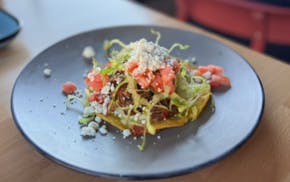You only need to stroll past the hummus section of the grocery store to realize it's a lot bigger than it used be. The fact that there is even a hummus section, with many, many varieties, tells us how popular this bean dip has become over the past few years.
Of course, hummus has been around for centuries, originating in the Middle East, but the hummus many of us know here in the United States is quite different than what you'd find in the markets of Cairo.
Our hummus tends to be less smooth, have more seasonings and flavorings and less tahini. We typically serve it cold, unlike the warm or room temperature versions in the Middle East.
While I am happy to dip a pita chip through a tub of store-bought hummus, if you've never tried to make it yourself, you're missing out. Homemade hummus is a rich, creamy revelation, and it's not hard to make.
A basic hummus should have only a handful of ingredients — chickpeas, tahini, garlic, lemon juice, ice water and salt. Yes, olive oil is also important, but it should be drizzled over the top of the finished hummus, not incorporated in the hummus itself.
While a good hummus is easy to pull together, it helps to know a few things.
Canned chickpeas vs. dried
I love making my hummus from good quality dried chickpeas (or garbanzo beans) and, until recently, I thought that was the only way to get to a more traditional version. Then my vegan, hummus-loving son mentioned that he gets great results from canned chickpeas, with one added step — and that step is a critical one.
He simmers the canned chickpeas for a short time with a touch of baking soda, which helps soften the chickpea skins, resulting in a smoother, creamier texture.
While I have been soaking dried chickpeas overnight in water with a little baking soda and then simmering them for a couple of hours in water with a little more baking soda, I hadn't tried it with canned beans and it's a game changer when time is of the essence.
Just dumping the cans of chickpeas into a food processor can lead to a thick, stodgy paste. Simmering them in baking soda-laced water is the first step to light, ultra-smooth, ultra-creamy hummus. Using canned chickpeas also makes it possible to whip up a batch of hummus in under 45 minutes.
Tahini
Good quality tahini, and plenty of it, is the next step to hummus perfection.
Tahini is a paste made from ground sesame seeds. You can find it in most grocery stores, but that doesn't mean it's going to be good. Often, you'll see jars of it that have separated, with a layer of oil at the top and a layer of thick, even hard, chalky paste at the bottom. This can mean the jar has been sitting for awhile, or it may not have been processed properly to begin with.
I try to buy my tahini at a Middle Eastern market, where the selection will likely be higher quality, or online. I generally look for tahini made in the Middle East, although there are some good U.S. brands, too. It should be creamy and light in color, with just a hint of bitterness.
While almost all hummus recipes include tahini, the good ones include a generous amount. Not a tablespoon or two, but something closer to a cup. It gives the hummus a creamy nuttiness that's absolutely essential.
Cold water
To achieve an ultra-smooth hummus, you'll have to blend it for a while. I've found my blender works much better than my food processor for this task.
Unfortunately, the blending process creates heat, which can negatively affect the taste and texture. Adding icy cold water can help regulate the temperature, resulting in lighter, creamier hummus.
The ice water is also important, as it loosens the hummus in the blending process. Tahini can tighten when mixed with other ingredients, causing the hummus to become so thick that an air pocket is created by the blender blade and the hummus stops processing. To prevent this, you'll likely have to stop and stir the mixture a few times while you're adding the ice water until you get the smooth, light consistency you're looking for.
Once you've made basic hummus, you can simply mound it in the center of a bowl and use the back of a spoon to swirl it toward the side, creating a well in the middle.
Filling the well can be as easy as drizzling in good-quality olive oil, or you can get more elaborate with your toppings. (I've given you a few good ideas below.)
You can also mix the basic hummus with a few extra ingredients, to take it to the next flavor level, as I've done here with the Avocado and Herb or Spicy Roasted Carrot versions.
Of course, a good pita to swipe into your deliciously addictive hummus is a beautiful thing, and making your own is a snap. But feel free to shop around for thick, fluffy, fresh pitas if you're short on time.
Easy Ultra-Smooth Hummus
Makes about 3 cups.
Using canned chickpeas that simmered in water laced with a touch of baking soda, lets you make a super creamy, smooth hummus in much less time than when you start with dried beans. From Meredith Deeds.
- 2 (15-oz.) can chickpeas, thoroughly rinsed and drained or 3 c. cooked chickpeas
- ½ tsp. baking soda
- ¾ c. tahini
- ¼ c. lemon juice (from 1 ½ to 2 lemons), more to taste
- 4 cloves garlic, roughly chopped
- Salt
- ⅓ c. ice water, plus more as needed
- Good quality extra-virgin olive oil, for drizzling
Directions
Place the rinsed and drained chickpeas in a medium saucepan. Cover with 2 inches of water. Stir in baking soda. Bring to a boil over medium-high heat. Reduce heat to medium and cook, stirring occasionally, for 35 to 45 minutes, until very tender, almost falling apart. Skim any skins from the top of the cooking water. Drain chickpeas.
Place chickpeas in a blender with tahini, lemon juice, garlic and ½ teaspoon salt. Purée until a thick paste forms, stopping frequently to scrap the hummus down to keep the blender running. With the motor running, slowly drizzle in ice water and allow it to mix for about 2 to 3 minutes, scraping down as necessary, until you get a very smooth and creamy paste. Drizzle in a little more water if the mixture is too thick. It will continue to thicken as it sits.
Transfer hummus to a bowl, cover surface with plastic wrap, and let it rest for at least 30 minutes. Taste and stir in more lemon juice, salt or water, if necessary. If not using immediately, refrigerate until needed, up to 2 days. Remove from fridge at least 30 minutes before serving.
To serve: Spoon desired amount of hummus onto a plate or shallow bowl and swirl with the back of a spoon to create a well. Drizzle with olive oil or top as desired.
HUMMUS TOPPINGS
Chickpeas with Parsley and Garlic
- ⅓ c. canned or cooked chickpeas, rinsed and drained
- ¼ c. extra-virgin olive oil
- 2 tbsp. finely chopped parsley
- 1 clove garlic, finely chopped
Directions
In small bowl, mix all the ingredients together and spoon onto hummus.
Harissa, Pine Nuts and Cilantro
- ¼ c. extra-virgin olive oil
- 2 tbsp. harissa
- 2 tbsp. finely chopped cilantro
- 2 tbsp. toasted pine nuts
Directions
In a small bowl, combine the oil and harissa. Spoon onto the hummus. Sprinkle the cilantro and pine nuts over the top.
Crispy Garlic and Oil
- ⅓ c. extra-virgin olive oil
- 4 cloves garlic, peeled and thinly sliced
Directions
Heat the oil in a small saucepan over a medium heat. Add the garlic and cook for 1 to 2 minutes, or until lightly golden. Strain the fried garlic through a sieve set over a heatproof bowl to catch the oil (this stops the garlic from cooking). Spoon the oil over the hummus and sprinkle the garlic over the top.
Spicy Roasted Carrot Hummus
Makes about 2 ¼ cups.
Note: Harissa is a Tunisian hot chile pepper paste, often found in the global aisle of the grocery store. Sriracha sauce is a good substitute. From Meredith Deeds.
- 2 large carrots, peeled, trimmed and cut into 1-in. pieces
- ¼ c. plus 1 tbsp. extra-virgin olive oil, divided
- ¼ tsp. ground coriander
- ½ tsp. ground cumin
- ¼ tsp. salt
- 1 ½ c. Easy Ultra-Smooth Hummus (see recipe)
- 3 tbsp. harissa, divided (see Note)
- 2 tbsp. toasted pepitas
Directions
Preheat the oven to 425 degrees. In a medium bowl, combine the carrots, 1 tablespoon oil, coriander, cumin and salt. Toss to coat. Place in an even layer on a rimmed baking sheet. Bake for 20 to 25 minutes, until tender and lightly browned in spots.
Transfer roasted carrots to a blender. Add the hummus and 2 tablespoons harissa and purée until smooth.
In a small bowl, combine the remaining ¼ cup olive oil and remaining 1 tablespoon harissa (it won't combine completely, but that's fine).
To serve: Spoon hummus onto a plate or shallow bowl and swirl with the back of a spoon to create a well. Spoon the harissa oil into the center and sprinkle the pepitas over the top.
Avocado and Herb Hummus
Makes about 2 ¼ cups.
This vibrant green hummus makes for a nice change from guacamole for avocado lovers. From Meredith Deeds.
- 1 large avocado, peeled and pitted
- ¼ c. coarsely chopped cilantro
- ¼ c. coarsely chopped parsley
- 1 ½ c. Easy Ultra-Smooth Hummus (see recipe)
- ¼ c. extra-virgin olive oil
- 2 tbsp. finely chopped parsley and cilantro
Directions
In blender combine avocado, cilantro, parsley and hummus. Purée until smooth.
In a small bowl, combine the oil and finely chopped parsley and cilantro.
To serve: Spoon hummus onto a plate or shallow bowl and swirl with the back of a spoon to create a well. Drizzle the herb oil over the top.
Pita Bread
Makes 10 pitas.
A food processor pulls this dough together in seconds, but you could also make it by hand or in a stand mixer (kneading for 5 to 7 minutes, until soft and elastic). From Meredith Deeds.
- 4 c. (480 g) unbleached all-purpose flour
- 2 ¼ tsp. active dry yeast
- 1 ½ tsp. salt
- 1 tsp. sugar
- 1 ½ c. lukewarm water (105 to 115 degrees)
- 2 tbsp. extra-virgin olive oil
- Cornmeal
Directions
Place the flour, yeast, salt and sugar in the bowl of a food processor and pulse a few times to combine. Turn on the processor and quickly pour the water and oil through the feed tube. Process until the dough forms a ball. Let the dough sit for 15 minutes. Process for 30 seconds. The dough should be soft, and a little sticky, but should be releasing from the bowl. If the dough seems too wet, add more flour, 1 tablespoon at a time.
Remove the dough from the processor and form into a ball. Place in an oiled bowl and cover with plastic wrap. Let rise until doubled, about 1 hour.
Preheat to 450 degrees.
Turn the dough out onto a lightly floured surface and knead two or three times to remove any air bubbles. Form into a log and divide evenly into 10 pieces. Form each piece into a ball. Let the balls rest for 10 minutes.
Working with one or two pieces at a time and keeping the rest covered, roll each piece into a 6-inch disk about ¼ inch thick. Place 4 pitas on a large baking sheet and bake for 5 to 7 minutes, or until puffed and just slightly browned on the bottom. Place in a large, clean dish towel to keep them warm and soft. If not using right away, cool on rack and place in zip-top plastic bag. Repeat with the remaining dough.
To make pita chips: Brush both sides of baked pita with extra-virgin olive oil and then with sea salt. Cut into wedges. Arrange in a single layer on a baking sheet and bake at 425 degrees for about 10 to 15 minutes, or until golden brown; the chips will continue to crisp as they cool.
Meredith Deeds is a cookbook author and food writer from Edina. Reach her at meredithdeeds@gmail.com. Follow her on Instagram at @meredithdeeds.

What we lose when chain drugstores replace family-owned independents
![George Floyd's daughter Gianna Floyd, 6, looks to her mother Roxie Washington during a press conference at Minneapolis City Hall. ] LEILA NAVIDI •](https://arc.stimg.co/startribunemedia/WSDMNXVK3VZJDLDP3BTMCSMXNU.jpg?h=91&w=145&fit=crop&bg=999&crop=faces)
Medcalf: Hateful comments made after recent column on George Floyd's daughter left me discouraged

John Cusack dishes on 'High Fidelity' at Minneapolis screening

For 'Legally Blonde' star, 'being underestimated is her secret superpower'
